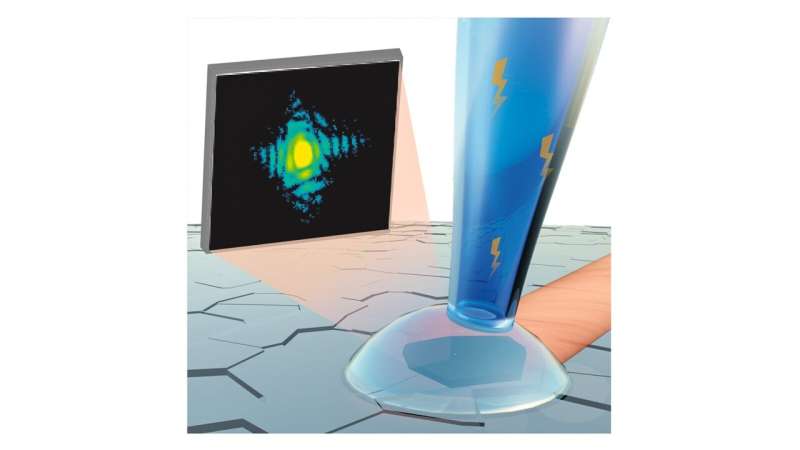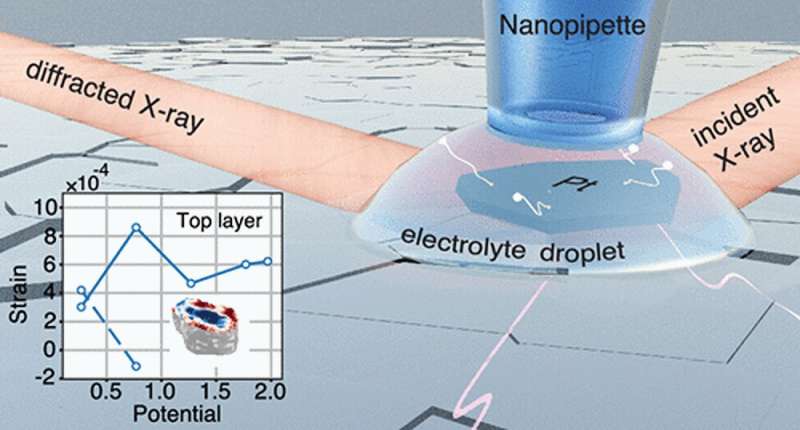This article has been reviewed according to Science X's editorial process and policies. Editors have highlighted the following attributes while ensuring the content's credibility:
fact-checked
peer-reviewed publication
trusted source
proofread
X-ray beams help researchers learn new tricks from old metals

A research team led by the U.S. Department of Energy's (DOE) Argonne National Laboratory used powerful X-ray beams to unlock a new understanding of materials important to the production and use of hydrogen. The goal is to make hydrogen production and usage more efficient and less expensive, offering a better fuel for transportation and industry.
"Efficient hydrogen production is key," said Hoydoo You, an Argonne senior physicist. "Hydrogen is the lightest energy storage material. Hydrogen can be produced from water using renewable energy or excess energy, transported as a fuel, and converted back to water to produce energy for consumers. Platinum and its alloys are best in catalyzing and boosting the water-splitting process by accelerating the exchange of electrons."
Understanding and developing materials enabling efficient production and usage of hydrogen are key to the hydrogen economy. The researchers made a first step in developing a tool that enables them to characterize the materials with a new level of detail, ultimately producing the best materials for hydrogen production and use.
"This will make production and use of hydrogen less costly and more environmentally friendly," You said.
The research team made use of the Advanced Photon Source (APS), a DOE Office of Science user facility at Argonne. Working at the APS, researchers aimed an intense X-ray beam onto a single grain of platinum. Diffraction patterns from that grain were collected on an X-ray detector. Those patterns were converted into images of the sample using customized computer algorithms.
A nanodroplet chemical cell, created with a tiny pipette tip (a tool for making a small droplet of liquid), was used to control the chemical reaction happening on the platinum grain to produce hydrogen in an electrolyzer. An electrolyzer is a device for producing hydrogen fuel from water using electricity; the device in a reverse operation, known as a fuel cell, converts hydrogen fuel back to electricity.

"The reaction was controlled by applying voltage, directed through an electrolyte in the nano-pipette onto the grain being studied," said Argonne physicist Matt Highland. He designed the initial prototype of this new tool. This prototype enabled the investigation of a single nanograin and opened a door for scanning capability over all grains in a realistic electrolyzer or fuel cell when the APS upgrade is completed. He also helped with the data collection and experiments.
Argonne physicists Ross Harder and Wonsuk Cha worked at the APS beamline 34-ID-C, where the experiments were performed, and helped with integrating the new electrochemistry tool in the existing instrument.
"The ability to do localized electrochemistry while creating a new picture of the way things were happening, at a single particle level, was incredible," Harder said.
The APS currently delivers X-ray beams that are up to a billion times brighter than those used by a dentist. But an extensive upgrade will make the APS even more powerful. When the upgraded APS comes online in 2024, its X-ray beams will be up to 500 times brighter than today. This means that techniques like the one used in this research will get even better after the upgrade.
"The APS upgrade will help us see things happen in real time in the material," said Harder. "Measurement times could become fast enough that we can move from one particle to another, and we could see how they are interacting with the electrochemical environment and each other."
"Important processes like battery charging and corrosion require the real-time imaging of grains to understand a full picture of the process," said Argonne assistant physicist Dina Sheyfer. "We believe the added brightness of the APS upgrade with our new tool will enable studies we can only dream about today."
The work is published in the journal Nano Letters.
More information: Dina Sheyfer et al, Operando Nanoscale Imaging of Electrochemically Induced Strain in a Locally Polarized Pt Grain, Nano Letters (2022). DOI: 10.1021/acs.nanolett.2c01015
Journal information: Nano Letters
Provided by Argonne National Laboratory



















